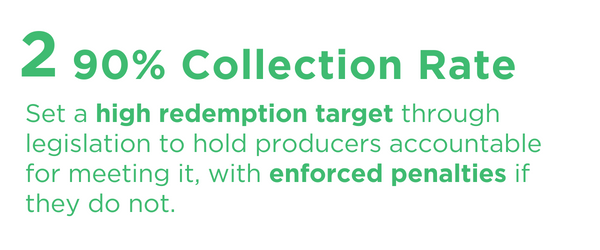Hello again!
This second issue of Bottle Bill Common Ground — a limited-series newsletter from Reloop North America highlighting evidence-based guidance for legislators, policy makers, industry, and advocates working on bottle bills — focuses on Principle #2 of the 10 high-performance principles for an effective deposit return system (DRS). (If you missed the first issue on Principle #1, Easy & Equitable, you can read it here.)
 Establishing an ambitious collection rate target through legislation is critical to a high-performing DRS. From the outset, it defines a common goal for producers, retailers, and regulators, encouraging cooperation. Public policy impact can then be measured by the yardstick of meaningful targets. Otherwise it is impossible to assess the effectiveness or efficiency of the DRS.
Establishing an ambitious collection rate target through legislation is critical to a high-performing DRS. From the outset, it defines a common goal for producers, retailers, and regulators, encouraging cooperation. Public policy impact can then be measured by the yardstick of meaningful targets. Otherwise it is impossible to assess the effectiveness or efficiency of the DRS.
Most importantly, setting a 90% collection target ensures the DRS is designed to maximize waste prevention, litter reduction, and facilitate high levels of closed-loop recycling. Yes, a 90% target is ambitious but it is also clearly attainable — countries like Denmark, Finland, Germany, Norway, and Lithuania routinely exceed their 90% collection target. And stakeholders along the value chain in Europe are leading the way.
- An industry-led coalition in Europe came together to propose the European Commission introduce a 90% separate collection for recycling target by 2029 for beverage container packaging.
- That same industry coalition also called for adoption of DRS in member states whose collection performance fails to meet interim milestones needed to attain the 90% target.
Reloop North America’s research on the impacts of DRS modernization modeled a 90% collection rate in five Northeast states and found these environmental impacts:
- 9.3 billion additional beverage containers recycled
- Reduction of greenhouse gas emissions equal to taking 121,000 cars off the road annually
- Up to a 34% reduction in overall litter
 Perverse outcomes can result when collection targets are not as robust as 90%. For example, an inaccessible or inconvenient redemption network is simultaneously bad for the consumer experience (see Bottle Bill Common Ground #1) yet translates into lower system costs and greater unclaimed deposit funds. Because of this, producers financing the systems and state agencies each may benefit from those unclaimed deposits. High redemption targets incentivize producers to optimize the user experience and access to return points.
Perverse outcomes can result when collection targets are not as robust as 90%. For example, an inaccessible or inconvenient redemption network is simultaneously bad for the consumer experience (see Bottle Bill Common Ground #1) yet translates into lower system costs and greater unclaimed deposit funds. Because of this, producers financing the systems and state agencies each may benefit from those unclaimed deposits. High redemption targets incentivize producers to optimize the user experience and access to return points.
We encourage you to subscribe to Bottle Bill Common Ground and share it widely with those who would want or need to know about these principles and practices. Working together from a common ground of knowledge, we can move good bottle bills forward.
